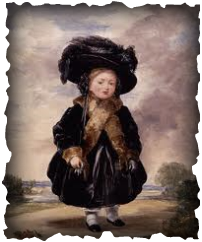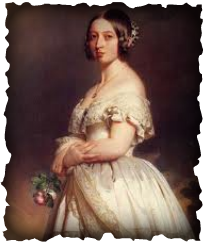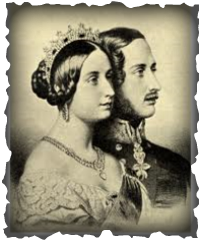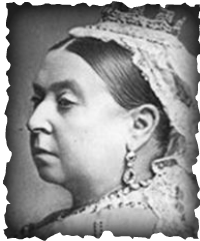Queen Victoria (1819-1901)
The Ideal Victorian Woman
Queen Victoria (1819-1901) reigned as the monarch of United
Kingdom and Ireland. Her reign was the longest compared to all British monarchs
and longest amongst all female rulers (63 years). The Victorian era was a
prosperous time of growth in technology and the expansion of British empire. Queen Victoria marked a time of transition for women, in feminism and women's rights. Her popularity and more superior status as Queen compared to her husband Prince Albert may be indicative of an emerging trend of self-empowered women; however, Queen Victoria modeled the conventional woman, belonging to the household and taking care of her children. Her perspective on feminist is clear:
"I am most anxious to enlist everyone who can speak or write to join in checking this mad, wicked folly of "Women's Rights," with all its attendent horrors, on which her poor feeble sex is bent, forgetting every sense of womanly feelings and propriety. Feminists ought to get a good whipping. Were woman to "unsex" themselves by claiming equality with men, they would become the most hateful, heathen and digusting of begins and would surely perish without male protection.I love peace and quiet, I hate politics and turmoil. We women are not made for governing, and if we are good women, we must disike these masculine occupations." -Queen Victoria, 1870
The source of the quote can be found here.
Queen Victoria almost seemed anti-feminist and fully supported male superiority and female submissiveness. She was the icon of Victorian women, her marriage to Prince Albert and the production of nine children. However, is the Queen's desire for marriage and children the absolute truth? Perhaps not.
She was quoted to have said the following:
"I feel sure that no girl would go to the altar if she knew all."
"When I think of a merry, happy, free young girl - and look at the ailing, aching state a young wife generally is doomed to - which you can't deny is the penalty of marriage."
"I think people really marry far too much; it is such a lottery after all, and for a poor woman a very doubtful happiness."
(For more quotes that Queen Victoria had been cited to have said or written, see here.)
Queen Victoria abided to and encouraged the female norms of domesticity and marriage, but it seems doubtful as to whether she truly believed in marriage. Her affection for Prince Albert was genuine; however marriage seemed to serve more of a political and obligated motive (the need for women to be married and to produce children to be heir to the throne) rather than a celebration of their love.
Queen Victoria did not enjoy child-bearing and her renowned quote exemplifies this: "An ugly baby is a very nasty object- and the prettiest is frightful". Despite her lack of enthusiasm for children, she understood her role and obligation, producing nine children; four sons and five daughters. This is particularly intriguing as Carroll's "Alice's Adventures in Wonderland" depicted the Duchess and her baby (which became a pig). Evidently, the Duchess neglects the baby, and flings it to Alice when she needs to play croquet with the Queen. The verses to the Duchess' lullaby-"speak roughly to your little boy, and beat him when he sneezes"(p. 58), is as violent as the way she tosses the baby up and down. She was quoted to have referred to the behavior of children as that of "rabbits and guinea pigs", and interestingly, Carroll portrays children as pigs in the book. It is unclear whether Carroll wanted to foreshadow the Queen's aversion through the Duchess, but interestingly he had a similar dislike of babies as well.
"'If [the baby] had grown up,' [Alice] said to herself, 'it would have made a dreadfully ugly child: but it makes rather a handsome pig, I think." - p. 60-61, Alice's Adventures in Wonderland
Brady (1998) suggested that Carroll's unpleasant childhood contributed to his despise for children:
"The cause of this neglection was the birth of four other siblings before he was six, leading to a loss of attention for himself. "Neither Charles Dodgson or Lewis Carroll had many good things to say about babies. 'Throw them away.' 'Tie them in knots and send them into the wilderness.' 'Roast them well and serve them as appetizers for the main meal."
Carroll's lack of passion for children is evident, but his association of children with pigs is intriguing. A possibility would be Carroll's non-nonsensical and playful style, but the underlying meaning emphasizes his underlying dislike of not children, but male children. Gardner (1960) proposed this possibility as Carroll apparently written that he found boys horrid.
"I am most anxious to enlist everyone who can speak or write to join in checking this mad, wicked folly of "Women's Rights," with all its attendent horrors, on which her poor feeble sex is bent, forgetting every sense of womanly feelings and propriety. Feminists ought to get a good whipping. Were woman to "unsex" themselves by claiming equality with men, they would become the most hateful, heathen and digusting of begins and would surely perish without male protection.I love peace and quiet, I hate politics and turmoil. We women are not made for governing, and if we are good women, we must disike these masculine occupations." -Queen Victoria, 1870
The source of the quote can be found here.
Queen Victoria almost seemed anti-feminist and fully supported male superiority and female submissiveness. She was the icon of Victorian women, her marriage to Prince Albert and the production of nine children. However, is the Queen's desire for marriage and children the absolute truth? Perhaps not.
She was quoted to have said the following:
"I feel sure that no girl would go to the altar if she knew all."
"When I think of a merry, happy, free young girl - and look at the ailing, aching state a young wife generally is doomed to - which you can't deny is the penalty of marriage."
"I think people really marry far too much; it is such a lottery after all, and for a poor woman a very doubtful happiness."
(For more quotes that Queen Victoria had been cited to have said or written, see here.)
Queen Victoria abided to and encouraged the female norms of domesticity and marriage, but it seems doubtful as to whether she truly believed in marriage. Her affection for Prince Albert was genuine; however marriage seemed to serve more of a political and obligated motive (the need for women to be married and to produce children to be heir to the throne) rather than a celebration of their love.
Queen Victoria did not enjoy child-bearing and her renowned quote exemplifies this: "An ugly baby is a very nasty object- and the prettiest is frightful". Despite her lack of enthusiasm for children, she understood her role and obligation, producing nine children; four sons and five daughters. This is particularly intriguing as Carroll's "Alice's Adventures in Wonderland" depicted the Duchess and her baby (which became a pig). Evidently, the Duchess neglects the baby, and flings it to Alice when she needs to play croquet with the Queen. The verses to the Duchess' lullaby-"speak roughly to your little boy, and beat him when he sneezes"(p. 58), is as violent as the way she tosses the baby up and down. She was quoted to have referred to the behavior of children as that of "rabbits and guinea pigs", and interestingly, Carroll portrays children as pigs in the book. It is unclear whether Carroll wanted to foreshadow the Queen's aversion through the Duchess, but interestingly he had a similar dislike of babies as well.
"'If [the baby] had grown up,' [Alice] said to herself, 'it would have made a dreadfully ugly child: but it makes rather a handsome pig, I think." - p. 60-61, Alice's Adventures in Wonderland
Brady (1998) suggested that Carroll's unpleasant childhood contributed to his despise for children:
"The cause of this neglection was the birth of four other siblings before he was six, leading to a loss of attention for himself. "Neither Charles Dodgson or Lewis Carroll had many good things to say about babies. 'Throw them away.' 'Tie them in knots and send them into the wilderness.' 'Roast them well and serve them as appetizers for the main meal."
Carroll's lack of passion for children is evident, but his association of children with pigs is intriguing. A possibility would be Carroll's non-nonsensical and playful style, but the underlying meaning emphasizes his underlying dislike of not children, but male children. Gardner (1960) proposed this possibility as Carroll apparently written that he found boys horrid.
The Queen and the Prince
Some have claim that the Queen of Hearts is a caricature of Queen Victoria, the authoritative and aggressive Queen and the timid, powerless King of Hearts in the 1951 animation. The unequal status (and size) of the Queen and King of Hearts may suggest likewise, paralleling the difference in Queen Victoria and Prince Albert's titles. In fact, Prince Albert never claimed kingship and his Prince status remained unchanged. However, Queen Victoria's devotion and compliance to Prince Albert, her desire for him to be King does not seem to be representative of the Queen and King of Heart's relationship in the animation. In fact, The Queen had an affair with The Knave of Hearts and The King of Hearts is implied to be killed by the Queen in Tim Burton's adaptation, his head amongst the other chopped heads floating in the bloody waters (See our character analysis on Red Queen and the photo of that scene).
Most notably, Queen Victoria went into seclusion and wore black for the remainder of her life due to Prince Albert's death. Her public appearance was greatly reduced and this led to her declining popularity. Tim Burton's film clearly contradicts this devastation and deep mourning for the King- the Red Queen is devoted to the Knave of Hearts and complete coldness and indifference towards her execution of the King's head, "I had to do it".
Possibly, there may be a link to Queen Victoria's submissiveness to her husband in Carroll's novel when the King acted as Judge for the tarts trial. The Queen of Hearts only rarely interfered with his judging. However, the fact that Victoria would ask for Prince Albert's approval before her actions is again, contrary to the portrayal of the Queen in the book, 1951 animation, and Tim Burton's film. Her decisiveness in execution ("Off with their heads") is not influenced by the King in any way and her power only increases throughout the adaptations.
Therefore, the Queen and feminine dominance may have been inspiration for Carroll to illustrate a unique and iconic Queen of Hearts; but on the other hand, the relationships and persona are argued to bear similar resemblance to Queen Victoria herself.
Most notably, Queen Victoria went into seclusion and wore black for the remainder of her life due to Prince Albert's death. Her public appearance was greatly reduced and this led to her declining popularity. Tim Burton's film clearly contradicts this devastation and deep mourning for the King- the Red Queen is devoted to the Knave of Hearts and complete coldness and indifference towards her execution of the King's head, "I had to do it".
Possibly, there may be a link to Queen Victoria's submissiveness to her husband in Carroll's novel when the King acted as Judge for the tarts trial. The Queen of Hearts only rarely interfered with his judging. However, the fact that Victoria would ask for Prince Albert's approval before her actions is again, contrary to the portrayal of the Queen in the book, 1951 animation, and Tim Burton's film. Her decisiveness in execution ("Off with their heads") is not influenced by the King in any way and her power only increases throughout the adaptations.
Therefore, the Queen and feminine dominance may have been inspiration for Carroll to illustrate a unique and iconic Queen of Hearts; but on the other hand, the relationships and persona are argued to bear similar resemblance to Queen Victoria herself.




